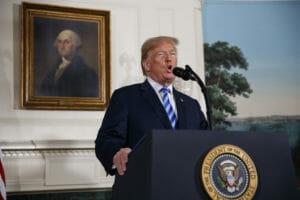America’s Confused Cause in Central Asia
Exactly what do we think we are doing in Afghanistan and Pakistan? Are we there to liberalize their forms of religious observance, or conduct a war over theology, or establish permanent NATO bases there, or are we searching for Osama bin Laden? It seems that we are doing all of these things at the same time. But why?Officials of the Pakistan government let it be known this week that in the Swat Valley region of the North West Frontier Province, once a popular Alpine-like tourist region, near the frontier with Afghanistan, they have made a peace agreement with the Taliban by which they have agreed to impose a religious regime compatible with the puritanical norms of the Taliban (or “Islamic Students'”) movement.
Since 2007, Taliban militants have waged what now has proven a successful campaign to impose their religious standards in the area, occupied by some 12,000 Pakistani troops. Their Taliban challengers are numbered in newspaper reports as around some 3,000 men
Their campaign has not been meant to establish actual military occupation and control, but to impose their norms of Muslim piety and worship through what might be called reinforced persuasion. They have assassinated officials and community leaders opposed to them, and attacked ordinary people who do not display the outward signs of strict religious observance, or whose conduct violates the Taliban’s own strict interpretations of the Koran and what is known as the Sunnah, a compendium of the sayings and teachings of the Prophet Muhammad.
The agreement signed by the Pakistan political authorities accepts the Taliban’s strict application of Shariah law.
This decision has been received with dismay by American officials who have demanded that the Pakistan army drive out these militants, who are part of the larger Taliban movement in northwestern Pakistan that is attempting — with notable success — to drive foreign troops out of neighboring Afghanistan, together with the U.S.-supported Hamid Karzai government in Kabul.
Needless to say, Washington is alarmed by this deal between the Pakistani authorities and a dissident group of its own citizens. It is called a “perilous precedent,” as indeed it might prove to be, in terms of the conventional aims of the United States in that spectacular but politically tormented region. It certainly raises again a question this writer has asked a number of times in the past without getting a convincing answer, either from U.S. officials or from those of my colleagues who have worked in the region.
Exactly what do we think we are doing in Afghanistan and Pakistan? Are we there to liberalize their forms of religious observance, or conduct a war over theology, or take permanent control of Afghanistan (or Pakistan) and establish permanent NATO bases there (as some Afghans are convinced); or are we searching for Osama bin Laden and his principal collaborators, in order to bring them to justice for the 2001 attacks carried out against the New York World Trade Center towers and the Pentagon?
It seems that we are doing all of these things at the same time. But why?
It is essential that the new Obama administration give us an answer. Clearly we want Osama bin Laden, but it is equally clear (on the basis of present experience there, as in Iraq) that adding another 40,000 troops to the 40,000 already there, plus the NATO forces present, offers absolutely no assurance of success in capturing the head of al-Qaida.
Is it that we actually want permanent bases in Afghanistan? If so, the American public deserves an explanation of why this is so.
Do we want a permanent American client-state there, such as Iran was for us before the 1979 revolution, or as Iraq was at the time of the Iran-Iraq war in the 1980s, when Saddam Hussein was our man in the Middle East? (An episode yet to be clarified by the historians.)
Do we seriously want to crush Taliban religious belief and liberalize Islam? To send American clergymen, social reformers and feminist scholars there for a series of seminars? To run a new Inquisition at gunpoint, American-style?
What we currently are doing in Pakistan and Afghanistan is blowing up Pakistanis and Afghans The same New York Times story reporting this Swat Valley agreement noted in passing that, on Feb. 17, an American drone fired four missiles into still another area close to the Afghan border and killed 31 people, “according to a government official and a resident.”
As those who know the region mostly acknowledge, this war between the United States and the Taliban has, since the 2001 American invasion of Afghanistan, provoked something resembling a religious and nationalist uprising among ethnic Pathans. The Pathans are the largest tribal group in this part of Central Asia. They are held to number some 40 million closely allied tribal people.
The final question I would ask is simply whether this is the way Barack Obama and his team really want to take the American people during the next four years?
Visit William Pfaff’s Web site at www.williampfaff.com.
© 2009 Tribune Media Services Inc.
Your support matters…Independent journalism is under threat and overshadowed by heavily funded mainstream media.
You can help level the playing field. Become a member.
Your tax-deductible contribution keeps us digging beneath the headlines to give you thought-provoking, investigative reporting and analysis that unearths what's really happening- without compromise.
Give today to support our courageous, independent journalists.






You need to be a supporter to comment.
There are currently no responses to this article.
Be the first to respond.